Singin’ the A2 blues
Auto magnate Henry Ford once famously said that history is bunk. But his fellow Michigander James Partridge doesn’t believe it for a minute.
As founder of the nonprofit Ann Arbor Blues Society, Partridge’s mission is to revive the tradition of great live blues music that emanated from clubs, coffee houses, and concert venues across the city during the 1960s and ’70s. Mainly he dreams of resurrecting the landmark 1969 Ann Arbor Blues Festival and restoring the event to the national prominence it enjoyed nearly five decades ago.
That dream moved one step closer to reality on Saturday, Aug. 19, 2017, when an appreciative crowd of about a thousand fans spent a warm, sunny afternoon and evening at the Washtenaw Farm Council Grounds grooving to the music of nine blues acts gathered mostly from Michigan but with a few from farther afield.
The original Ann Arbor Blues Festival attracted 20,000 attendees, featured more than two dozen performers from around the country — including such living legends as B. B. King, Muddy Waters, Howlin’ Wolf, and Big Mama Thornton — and lasted for three days.
Partridge admits he’s got a long way to go. But it’s all part of the plan.
“My aims and goals are both modest and extremely ambitious,” he explains. “The first year, by necessity, was going to be small. We have limited resources, both human and financial. But that’s OK — it will take time to rebuild the festival, and I think we’ll be able to do that if we’re prudent with our resources and what we promise people. Over the next couple of years, my goal is to return the Ann Arbor Blues Festival to its place as one of the premier blues festivals in the country. In 2019, I want to have a festival that truly honors the 50th anniversary of that first festival in 1969.”
Partridge, a lawyer by day, says he never set out to be a concert promoter.
“I became a fan of the blues later in my life, when I started taking guitar lessons with my 10-year old son. The more I learned about the genre, the deeper my interest became. At one point, I thought it’d be great if there was a blues festival in Ann Arbor. I didn’t know much about the city’s history — not having moved here until 2001 — so imagine my surprise when I learned that not only did Ann Arbor used to have some pretty incredible blues and jazz festivals, but that a handful of University of Michigan students essentially invented the electric blues festival!”
The summer of ’17
White boy blues
Partridge isn’t the only one with an interest in the history of the Ann Arbor Blues Festival. Via his Nashville-based Third Man Records, Detroit rocker Jack White is working to release never-before-heard tapes recorded by some of the students who helped out at the original event nearly 50 years ago.
Explains Parker Fishel, an archivist with the Bob Dylan Music Company: “My uncle John Fishel [BA ’70/MSW ’73] was co-chair of the ’69 festival. By dint of this connection, my dad Jim Fishel and his friends found themselves volunteered as minders for the artists. Between their duties of seeing that the musicians were fed and provided with adequate libations, he and his friends managed to record about half of the festival. Other than the release of Magic Sam’s set on Delmark Records in 1981, these recordings sat in my family’s basement for almost 30 years.”In 2009, while at Columbia University, the younger Fishel began a project to preserve and digitize the tapes.
“With a small, dedicated team of student volunteers, we transferred and restored the recordings; identified the songs and performers; conducted over 35 oral history interviews with musicians, organizers, and attendees; and reconstructed the festival’s running order.”
Feeling that the recordings deserved a wider audience, they formed Americana Music Productions and asked Third Man to partner on a release.
“The challenge has been locating artists and estates to secure the necessary permissions,” explains Fishel. “But feedback has been positive and we’re well on our way. The release date is still to be determined, but our hope is that it will be no later than 2019 to coincide with the 50th anniversary of the recordings.”
Festival of the year
The first Ann Arbor Blues Festival got underway at 7:30 p.m. on Friday, Aug. 1, 1969. Over the coming weekend attendees were treated to nearly 24 hours of the best and most authentic blues the country had to offer, old and new, from city blues to rural blues, northern blues to southern blues, and everything in between.
In addition to King, Waters, Thornton, and Howlin’ Wolf, the lineup featured Lightnin’ Hopkins, Magic Sam, T-Bone Walker, Roosevelt Sykes, Son House, Junior Wells, Sam Lay, Charlie Musselwhite, James Cotton, Otis Rush, Freddy King, and Arthur “Big Boy” Crudup, as well talented up-and-comers like Luther Allison.
Critics were virtually unanimous in their praise. Norman Gibson of The Ann Arbor News perhaps put it best, writing simply that “the first Ann Arbor Blues Festival in history was a success from almost any point of view and those who arranged it can be proud of the results.”
Many reviewers preferred the more intimate Ann Arbor event to the mammoth Woodstock music festival that took place in upstate New York two weeks later. Writing in the October issue of Downbeat, critic Dan Morgenstern made his preference plain, dismissing Woodstock in favor of the Ann Arbor affair, which he declared was “without doubt the festival of the year, if not the decade.”
While Woodstock was remarkable largely because of the sheer size of its audience, the Ann Arbor Blues Festival was all about the music. “This particular happening did not attract even one-tenth of the 300,000-plus that Woodstock could boast,” wrote Morgenstern. “But everyone there had come to hear the music — not to make the scene — and the enthusiastic response was a joy to behold.”
The fact that the festival organizers were barely old enough to vote (21 back then) made it all the more amazing. Today it’s almost impossible to believe that a handful of University of Michigan undergraduates conceived, planned, and executed the first major blues festival in the United States.
But perhaps their most incredible achievement was to somehow persuade the University Activities Center and Canterbury House, the student Episcopalian organization, to put up $70,000 for the event. (That’s a jaw-dropping $466,000 when adjusted for inflation.)
Flushed with success after the ’69 festival — which managed to turn a profit of about $200 — the organizing committee planned an even bigger and better event for the following year. With increased media coverage and another unbelievable roster of stellar performers, the second Ann Arbor Blues Festival was once more an unequivocal artistic triumph, a joyous experience for audience and performers alike that earned the raves of critics from Downbeat, Rolling Stone, Billboard, and newspapers across the country.Financially, however, it was a disaster.
Hoping for a bigger turnout, organizers had slashed ticket prices by almost 30 percent. But the additional concertgoers failed to materialize — possibly because the 1970 Ann Arbor Blues Festival had the misfortune to take place the very same weekend as the gigantic Goose Lake rock festival in nearby Jackson, Mich. That event boasted an impressive lineup of major-label acts, including Chicago, Rod Stewart, Jethro Tull, Bob Seger, John Sebastian, Mountain, and Ann Arbor native Iggy Pop, drawing an estimated 200,000 attendees.
The potentially ruinous losses incurred by the second blues festival — between $20,000 and $30,000 — eventually were made up through donations and benefit concerts, but the damage had been done. There would be no blues in Ann Arbor for 1971.
Rainbows to the rescue
But all was not lost. The next year local hippie activist John Sinclair, BA ’64, and his Rainbow People’s Party took up the gauntlet, inaugurating the slicker, more professional Ann Arbor Blues and Jazz Festival, with a broader musical foundation and higher-profile performers such as Ray Charles, Count Basie, Miles Davis, James Brown, Dr. John, and Bonnie Raitt.
But the Rainbows couldn’t seem to make money out of it, either. Deeply in debt, Sinclair called it quits in 1974 and the Ann Arbor Blues and Jazz Festival lay dormant until being revived once more in 1992.
In this incarnation the festival would have its longest continuous run, surviving for nearly a decade-and-a-half. But once again the familiar pattern emerged: artistic success, financial failure. After the last festival in 2006 an accumulated debt of nearly $60,000 remained on the books.
Blue skies ahead?
Despite the fête’s long history of pecuniary woe, James Partridge believes he has every reason to be optimistic about the chances for a sustained revival of the Ann Arbor Blues Festival. The initial outing exceeded expectations, and he’s confident that it can be made to work this time around.
“Some unexpected developments helped make this year’s event extra-special,” he says, “and really helped establish the link between previous festivals and the current iteration. The first was that Ron Marabate [BA ’70/MS ’71], technical director for the very first blues festival in 1969, made the trip from Lansing to attend. It was a thrill to meet him and hear him tell stories of that first festival.
“Another surprise came on Friday afternoon, when a couple of people drove up and introduced themselves as associates of Prism Productions, the organization that put on the Blues and Jazz Festivals beginning in 1992. They opened the trunk of their car, revealing the backdrop that had hung behind the main stage at their productions of the Ann Arbor Blues and Jazz Festivals and asked if we would like to have it for our event. It took me about 3 milliseconds to say yes.
“We even got a break from Mother Nature,” Partridge adds. “As late as Friday, the forecast called for rain and possible thunderstorms in the afternoon of the festival, but the day was perfect — blue skies and relatively cool temperatures for August.”

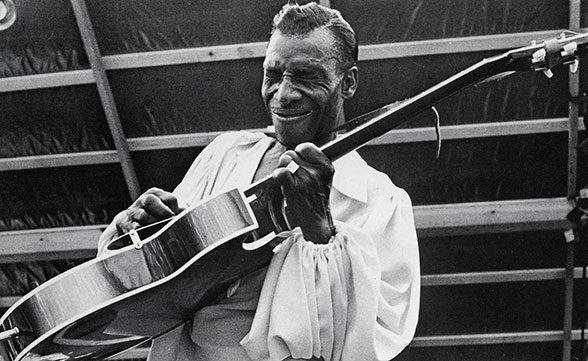
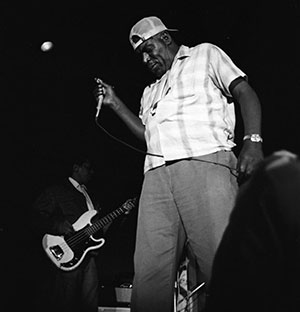
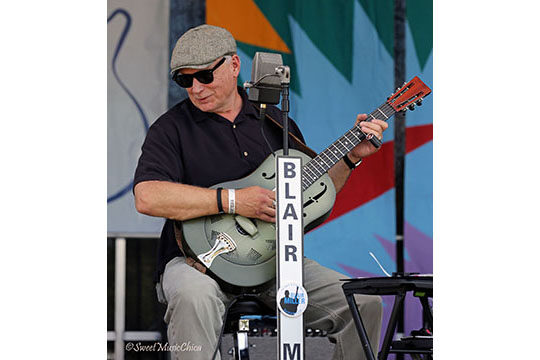

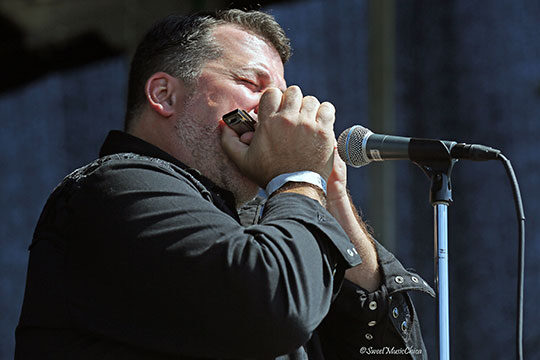




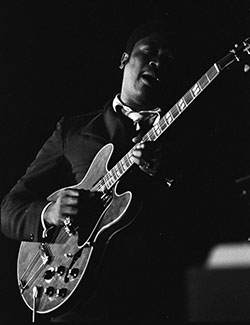



Steve Rauworth - 1970
I lived in Ann Arbor after graduating in 1970 and went to a number of the early festivals, precisely which years I can’t remember, though I distinctly remember some of the performances – Bonnie Raitt joining Sippie Wallace, and the Sun Ra Arkestra playing their cosmic tunes under the stars. And I do remember that because of some disagreement with the city, the festival was held “in exile” somewhere in Ontario in 1974.
U.S. law enforcement grabbed this opportunity to crack down on hippies, actually illegally preventing many of us from crossing the border. But my wife and I made it across, and had a blast at the festival, but were detained coming back by U.S customs, who ripped our car apart, including removing all the door panels and leaving them and all of our stuff laying on the pavement for us to put back together when they were done. It seemed to me they were particularly angry and frustrated because they found no drugs – we were not innocent, but also not stupid.
While I had been politically active before this, this very personal and outrageous violation enraged me to new awareness of the nature of my country. Some things haven’t changed much.
Reply
Karen Mueller - MSW 1970
These were probably the most amazing music events I have ever experienced. I was there in 69 and 70. The music was raw, fresh, amazing. Also clearly, most of these performers, even the famous ones, never made much money from music, which was an early (for me) lesson in how racism works. I remember hearing that one performer, an old man and amazing guitar player, had driven his beat-up car from somewhere in the Deep South for $50 plus gas money in order to play. Willie Mae Thornton and Howlin’ Wolf were scary, powerful, totally dominating performers. And they were only a few among the many who seemed to pour heart and soul into the music. I never felt the same about rock and roll after seeing these shows.
Reply
Jack Cleary - MHA-1973
Thanks for this fine article that brought back great memories of my time at U-M. Isn’t the guitarist in the lead photo with the big Gibson acoustic-electric jazz guitar actually T-Bone Walker, not Son House?
Reply
Deborah Holdship
Here’s the link to the image at the Bentley, with an ID for Son House, FYI. In trying to compare images of both men online, it’s tough to tell. They really do look like one another. Thoughts?
http://quod.lib.umich.edu/b/bhl/x-hs16387/HS16387?from=index;lasttype=boolean;lastview=thumbnail;med=1;resnum=1;size=20;sort=relevance;start=1;subview=detail;view=entry;rgn1=ic_all;q1=Son+House
Reply
John Morrison - 1977
Good eye, Jack. I don’t know T-Bone Walker real well but I do know Son House and when I first saw the photo I didn’t question that it was correctly identified. After reading your comment and looking at the photo again, though, I agree it does not quite look like Son House in terms of physical appearance or guitar-playing style. I’m going dig deeper into this. It’s important stuff…let’s get it right!
Reply
Tim Faber - AB - 1984
I believe that is T-Bone Walker. Son House generally played an acoustic slide guitar while T-Bone played a hollow-body electric. The pose even looks similar to a number of T-Bone photos online.
Reply
Deborah Holdship
Well, the odds certainly favor T-Bone Walker. I’ve notified the Bentley Historical Library.
Reply
Kenneth Whipple - 1969, 1977
By way of introduction, I was the festival’s co-chair with John Fishel in 1970 and worked with John in 1969 on advertising and festival production, being the stage manager during the 69 concerts. I have a lot of great memories and stories from both years that I’d like to share with Alan Glenn, James Partridge and Parker Fishel. Could perhaps result in a short history of the 69 & 70 festivals. Trips with John to Chicago to hear recording sessions at Delmark Records, going to Walden Corners on the Southside to hear Freddie King, bring Luther Allison to Ann Arbor to begin his career outside of Chicago, picking up Mississippi Fred McDowell at the Mariposa Folk festival to bring him to the festival and having him stay at John’s house, BB King paying tribute to Hound Dog Taylor at one of the jam sessions at the Woman’s League, working with the infamous Sheriff Doug Harvey on festival crowd control, and on and on and on. 🙂 So I hope Alan, James and/or Parker will get in touch with me to discuss the 69 & 70 festivals. And I hope to learn where John is today. I have nothing but wonderful memories from helping to put on the festivals. Ken Whipple whippleken1@yahoo.com
Reply
Gary Salwin - 1970
It was a special time we will never forget. I’d like to add, Bonnie Rait played slide and also don’t forget Doctor John with his “Gree Green”
Reply
Kenneth Whipple - BA 1969, MHSA 1977
Actually Bonnie didn’t perform at the 69 or 70 festival, but at a later one. She was, however, at the 70 festival where I noticed her in one of the performer’s tents sitting beside John Johnson a blue man from Washington D.C. Seeming a little out of place with the performers, being a young red headed white woman. I asked who she was and learned that she came with Dick Waterman, a manager for several of the performers and that her dad was a notable in the Hollywood scene. This was before Bonnie became the “Bonnie Rate.” I have a lot of respect for her literally sitting at the feet of some great blues men learning THE blues.
Reply
John Morrison - 1977
Dick Waterman was also an excellent photographer and his coffee table book “Between Midnight and Day” is a terrific archives of anecdotes and photos of the greatest blues artists who were performing at the time of the first Ann Arbor Blues Festivals. Included are many photos Waterman took of performers at the 1969 AA festival…as well as a humorous story from that year’s festival involving Waterman, Bonnie Raitt, Mississippi Fred McDowell and a hotel room full of what Waterman described as blues-loving “nubile college girls”. Any of you Michigan women know more about that?
Reply
Kathy Gilroy - '72 BA Math
I was impressed by Sun Ra and Luther Allison at the ’73 B&J Festival. According to my diary, I got in free. I don’t remember how.
Reply
John Arevalo - 1981
Definitely T-Bone Walker. He played electric while Son House played acoustic guitar w/a slide and was much older than T-Bone.
Reply
John Morrison - 1977
My final conclusion as well. Again, as one who is only moderately familiar with T-Bone Walker I am only 90% sure that it is him, but I know with certainty the photo is not the legendary Son House…who by the way, died in Detroit and is buried beneath an adulating headstone at Mt. Hazel Cemetery on Lahser near Seven Mile Road.
Reply
Deborah Holdship
The jury is in. The lead image for this story, originally captioned (Aug. 26) as Son House, really is T-Bone Walker, as per Bentley Historical Library archivist Greg Kinney. He has since provided an image of the actual Son House, which I added to the story Aug. 30. Many thanks to all of you blues experts out there for catching this important bit of history!
Reply
Roger Rowe - 1982 MSW
I especially remember the Ann Arbor Jazz and Blues Festival when I was a teen in the early 1970’s. I remember John Lee Hooker!! Thanks for the article and work at bringing it back. When the festival does come back hope you will publish the dates of the festival in advance.
Reply
James Partridge
Thank you for publishing this story about the Ann Arbor Blues Festival. It has been especially meaningful for me to read all of the comments from those of you who attended the early festivals.
For those who are interested in next year’s event, it will be held on August 17-18, 2018 at the Washtenaw Farm Council Fairgrounds.
Reply